Ferroglobe Bundle
How is Ferroglobe Navigating the Electrometallurgy Market?
Ferroglobe PLC, a titan in silicon and manganese alloy production, is strategically positioned at the nexus of the global energy transition. Established in 2015, the company has evolved significantly, especially since the launch of its 'Value Creation Program' in 2020. This program was designed to revitalize its market competitiveness and enhance stakeholder value.
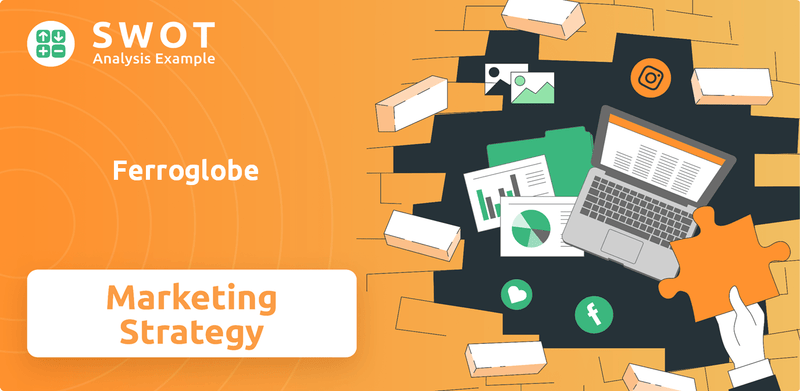
This deep dive into Ferroglobe's Ferroglobe SWOT Analysis will uncover the intricacies of its sales and marketing strategies, essential for understanding its financial performance. We'll explore its approach to Ferroglobe sales strategy and Ferroglobe marketing strategy, including how it addresses challenges like fluctuating raw material costs and evolving industry standards. Understanding the Ferroglobe business strategy is key to assessing its market position and future growth potential, including its Ferroglobe market analysis and strategies against Ferroglobe competitors.
How Does Ferroglobe Reach Its Customers?
The sales channels of Ferroglobe primarily revolve around a direct sales approach. This strategy is crucial for reaching its diverse customer base, which spans industries such as chemical products, aluminum, steel, solar energy, automotive, and foundries. Given the nature of its products—silicon metal, silicon-based alloys, and manganese-based alloys—direct relationships with manufacturers are essential.
These direct sales teams are responsible for facilitating large-volume, long-term contracts, a common practice in the industrial metals sector. Ferroglobe's global presence, with production facilities worldwide, supports this direct customer engagement by enabling local production and supply to local customers. This setup allows for efficient distribution and tailored service, which is vital for maintaining strong customer relationships.
The evolution of Ferroglobe's sales channels is closely tied to its strategic goal of becoming a global leader in silicon metal and ferroalloys. This involves maintaining solid relationships with current customers and expanding into rapidly growing markets like electric vehicles (EVs) and solar energy. The company is actively developing strategic partnerships and alliances, such as its investment in Coreshell Technologies to advance silicon-rich EV battery technology, which can be seen as a form of strategic channel development. Ferroglobe also expands commercial relationships in Asia and the Middle East, indicating a continuous effort to diversify and strengthen its market reach.
Ferroglobe's Ferroglobe sales strategy heavily relies on a direct sales model. This approach is essential for managing large-volume contracts typical in the industrial metals sector. It ensures that the company can provide tailored services and maintain strong relationships with its key customers across various industries.
Strategic alliances are key to Ferroglobe marketing strategy, especially in the EV and solar energy sectors. Investments like the one in Coreshell Technologies demonstrate the company's commitment to innovation and expanding its market reach. These partnerships are crucial for securing long-term supply agreements and boosting market share.
Ferroglobe’s global operational footprint supports its Ferroglobe business strategy. Production facilities worldwide enable local supply, optimizing the supply chain and enhancing customer service. This global presence is essential for meeting the growing demand for its products in various regions.
The business model is highly specialized, focused on business-to-business (B2B) transactions. The emphasis on 'Sales & Operations Planning (S&OP)' further indicates a structured approach to aligning production with customer demand and optimizing its supply chain. Key partnerships and exclusive distribution deals would likely involve long-term supply agreements with major players in the chemical, automotive, and solar industries, contributing to its market share and growth.
The company's sales strategy focuses on direct engagement and strategic partnerships to meet the evolving needs of its customers. This includes expanding production capacity and improving supply chain resilience. The expansion of the Ferro Silicon production facility in South Africa, announced in January 2024, is expected to increase output by 20% by the end of 2025.
- Direct Sales: Direct sales teams manage large-volume contracts and maintain customer relationships.
- Strategic Partnerships: Investments in new technologies and partnerships in emerging markets like EVs and solar energy.
- Global Operations: Production facilities across the globe support local supply and customer service.
- Supply Chain Optimization: Structured approach to aligning production with customer demand and optimizing its supply chain.
Ferroglobe SWOT Analysis
- Complete SWOT Breakdown
- Fully Customizable
- Editable in Excel & Word
- Professional Formatting
- Investor-Ready Format
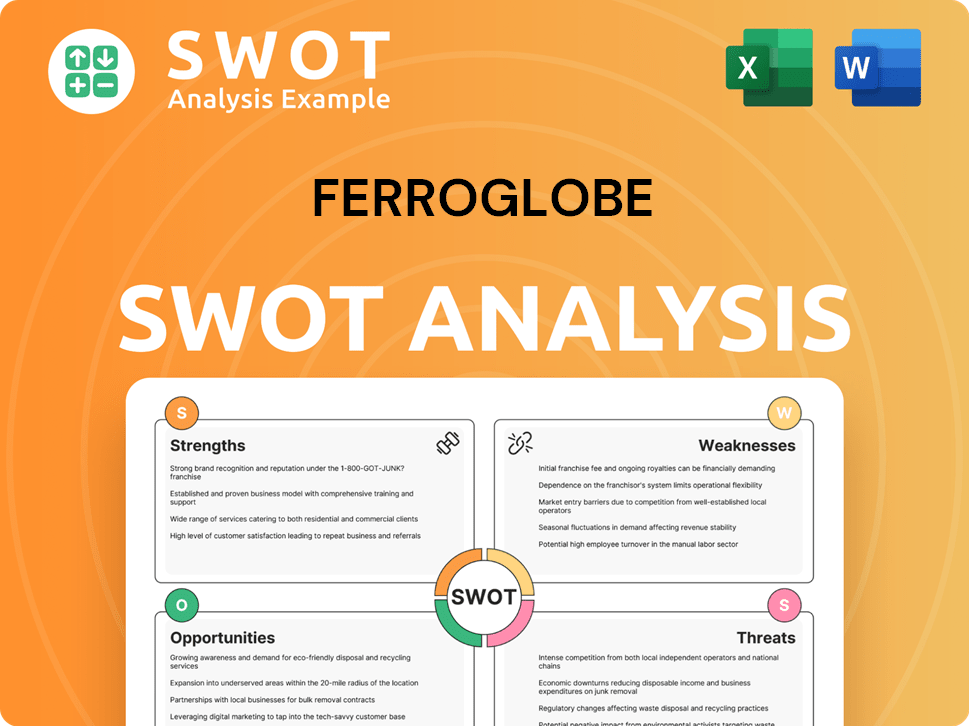
What Marketing Tactics Does Ferroglobe Use?
The marketing tactics of the company are primarily focused on business-to-business (B2B) industrial markets. These strategies aim to build brand awareness, generate leads, and drive sales within specialized sectors. The company's approach relies heavily on digital tactics and industry-specific engagements rather than traditional advertising methods.
A core element of the company's marketing strategy involves content marketing, which includes press releases and investor presentations. These materials highlight financial results, strategic initiatives, and market outlook. This approach helps to inform stakeholders and potential customers about the company's performance and future direction. For example, the company regularly publishes press releases regarding its quarterly financial results, such as the first quarter of 2025, which reported sales of $307.2 million.
The company also leverages investor relations platforms and its corporate website to disseminate information. These platforms include earnings call presentations and annual reports. These tools are crucial for keeping stakeholders and potential customers informed about the company's performance, strategic direction, and commitment to sustainability. The company's 2022-2026 ESG Strategy is a significant marketing and brand-building tool.
The company uses press releases and investor presentations to communicate financial results and strategic initiatives. This includes highlighting key developments and market outlook. The company's website and investor relations platforms are key tools for sharing information.
The 2022-2026 ESG Strategy is a marketing tool that reinforces sustainability as a strategic pillar. This helps appeal to an environmentally conscious customer base. The strategy is communicated through reports and public affairs efforts.
The company's emphasis on 'Sales & Operations Planning (S&OP)' suggests a data-driven approach. The goal is to align production with market demand and customer needs. This internal approach supports the Ferroglobe sales strategy.
Participation in industry conferences is a vital marketing tactic for direct engagement. The company uses these events to connect with investors and potential customers. The B. Riley Conference Investor Presentation in May 2025 and BMO Investor Presentation in February 2025 are examples.
The company highlights growth opportunities in the EV and solar markets at conferences. This showcases innovation and technical expertise. These events are key for the Ferroglobe marketing strategy.
The company's financial performance is a key aspect of its marketing efforts. The first quarter of 2025 showed sales of $307.2 million. This data is used in press releases and investor communications.
The company's marketing efforts are designed to support its overall business strategy. For more details on the company's business model, see Revenue Streams & Business Model of Ferroglobe. These activities help to build brand awareness and drive sales within the industrial market. The Ferroglobe business strategy includes a focus on sustainability and data-driven decision-making, which are communicated through various marketing channels. Key elements include:
The company focuses on content marketing, investor relations, and industry events to reach its target audience. This approach allows for direct engagement and the sharing of important information. The Ferroglobe market analysis informs these strategies.
- Content marketing through press releases and investor presentations.
- Use of investor relations platforms and the corporate website.
- Emphasis on the 2022-2026 ESG Strategy.
- Participation in industry conferences.
- Internal data-driven approach through Sales & Operations Planning (S&OP).
Ferroglobe PESTLE Analysis
- Covers All 6 PESTLE Categories
- No Research Needed – Save Hours of Work
- Built by Experts, Trusted by Consultants
- Instant Download, Ready to Use
- 100% Editable, Fully Customizable
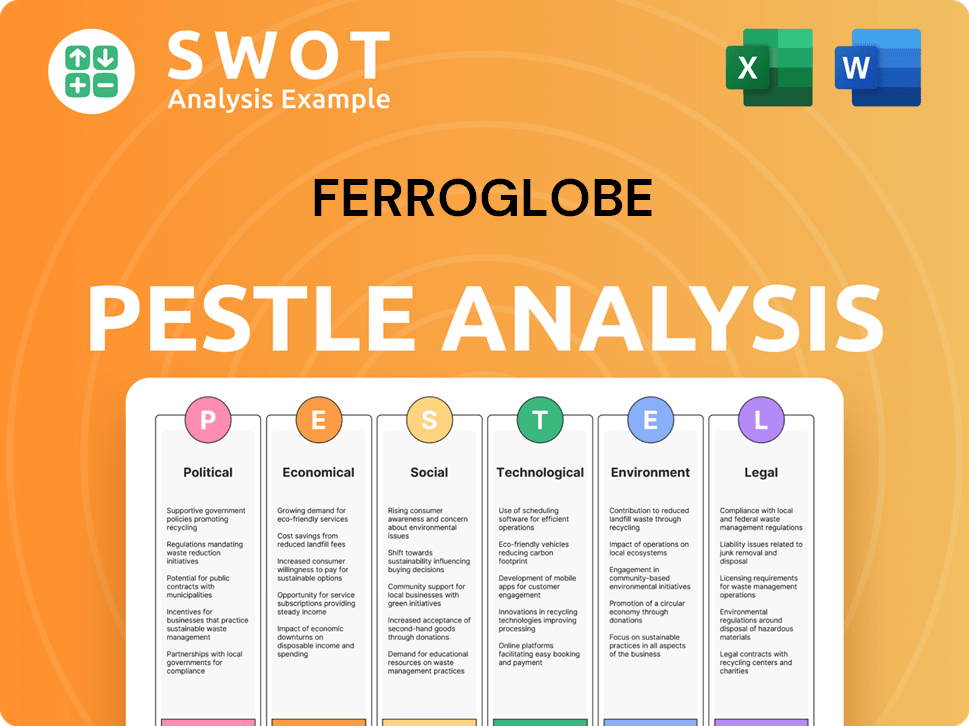
How Is Ferroglobe Positioned in the Market?
Ferroglobe strategically positions itself as a key provider of essential materials for a sustainable future. Its brand is built on innovation and technical expertise, emphasizing its commitment to environmental, social, and governance (ESG) principles, as outlined in its 2022-2026 ESG Strategy. The core message focuses on creating value for all stakeholders, aiming to become the leading global reference in silicon metal and ferroalloys. This approach is central to the company's Ferroglobe sales strategy.
The company differentiates itself through its integrated operational framework, which includes quartz and coking coal mining, providing a competitive edge over rivals that rely solely on external raw material sourcing. This integrated model supports its Ferroglobe marketing strategy by ensuring consistent quality and reliability. Ferroglobe's brand promise is supported by its global presence and adaptable production capabilities, allowing it to meet the diverse needs of its target markets effectively.
Ferroglobe's brand positioning is crucial for its Ferroglobe business strategy, enabling it to appeal to a wide range of industries, including solar, electronics, automotive, and construction. The company highlights its role in the energy transition, focusing on advanced technologies like high-purity silicon for batteries and its importance in manufacturing photovoltaic cells. This focus is crucial for maintaining and growing its market share.
Ferroglobe's target audience spans several industries, including solar, electronics, and automotive. This broad reach is supported by its ability to supply essential materials for various advanced technologies.
The central message revolves around being a value-creating company focused on sustainable profit and stakeholder value. This message is consistently communicated across all investor and public communications.
Ferroglobe's integrated operational framework, including its own mining operations, gives it a competitive edge. This integration ensures control over raw materials, supporting its production efficiency.
Brand consistency is maintained across all communications, including investor relations and press releases. This ensures a unified message about the company's strategic objectives and financial performance.
Ferroglobe actively responds to market changes and competitive threats. This includes participating in trade cases to ensure fair trade practices. For example, in late 2024, the U.S. Department of Commerce imposed duties on ferrosilicon imports from several countries, a move that Ferroglobe likely supported to stabilize the market.
- The company's proactive stance in addressing market imbalances helps maintain a competitive environment.
- This approach is crucial for protecting domestic producers and ensuring a level playing field.
- Recent trade actions, such as those in 2024, demonstrate Ferroglobe's commitment to market stability.
- These actions are part of a broader strategy to strengthen its market position.
For more in-depth information about the company's ownership and financial structure, consider reading about Owners & Shareholders of Ferroglobe.
Ferroglobe Business Model Canvas
- Complete 9-Block Business Model Canvas
- Effortlessly Communicate Your Business Strategy
- Investor-Ready BMC Format
- 100% Editable and Customizable
- Clear and Structured Layout
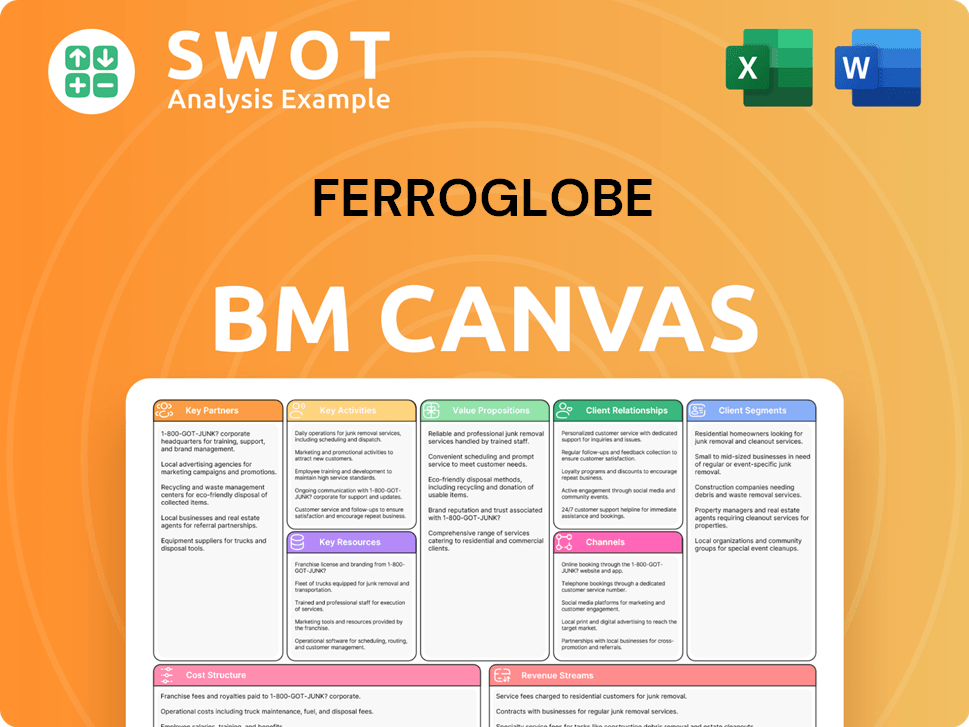
What Are Ferroglobe’s Most Notable Campaigns?
The sales and marketing strategies of Ferroglobe are centered around initiatives that enhance its market position and drive growth. These strategies, while not always traditional campaigns, are designed to improve efficiency and competitiveness. A key focus is on financial performance and market stability, with success measured through financial metrics and market share.
A significant aspect of Ferroglobe's approach involves actively participating in trade measures and anti-dumping cases. These actions are crucial for leveling the playing field, benefiting domestic producers, and encouraging local supply chain development. These efforts directly support sales by mitigating the impact of unfairly priced competitive products.
The company's strategic transformation plan, the 'Value Creation Program,' initiated in 2020, is a major ongoing initiative. The program aims to improve global efficiency, long-term profitability, and competitiveness, with a goal of becoming the reference in silicon metal and ferroalloys. This overarching initiative involved optimizing cost structures and strengthening the balance sheet, which by Q1 2024, saw Ferroglobe become net cash positive for the first time in its history.
The 'Value Creation Program' initiated in 2020, focuses on improving global efficiency and long-term profitability. This plan is designed to strengthen the company's financial position and competitiveness, aiming to make the company a leader in the silicon metal and ferroalloys market. This strategy is a critical part of Ferroglobe's overall Brief History of Ferroglobe.
Ferroglobe actively participates in trade measures and anti-dumping cases to support its sales. These efforts help mitigate the impact of unfairly priced products, ensuring fair competition. For example, in November 2024, the U.S. Department of Commerce announced duties on Russian, Brazilian, Kazakhstan, and Malaysian ferrosilicon imports.
The success of these initiatives is gauged by financial improvements and market stability. Ferroglobe's adjusted EBITDA guidance for 2025 of $100-$170 million reflects the anticipated positive impact of these trade measures and expected market improvements in the second half of 2025. The company's capital return program, including an 8% increase in its quarterly dividend to $0.014 per share in Q1 2025, boosts investor confidence.
The capital return program, including an 8% increase in its quarterly dividend to $0.014 per share in Q1 2025, and share repurchases, is a direct outcome of its strengthened financial position. This program boosts investor confidence. This supports the company's market standing.
The primary measures of success for Ferroglobe's sales and marketing strategies include financial improvements and market stabilization. The focus is on long-term profitability and competitiveness.
- Reduction in adjusted gross debt by approximately $370 million since the end of 2022.
- Estimated annual interest expense saving of $32 million.
- U.S. FeSi index prices increased by 17% since early April 2025.
- Adjusted EBITDA guidance for 2025 of $100-$170 million.
Ferroglobe Porter's Five Forces Analysis
- Covers All 5 Competitive Forces in Detail
- Structured for Consultants, Students, and Founders
- 100% Editable in Microsoft Word & Excel
- Instant Digital Download – Use Immediately
- Compatible with Mac & PC – Fully Unlocked
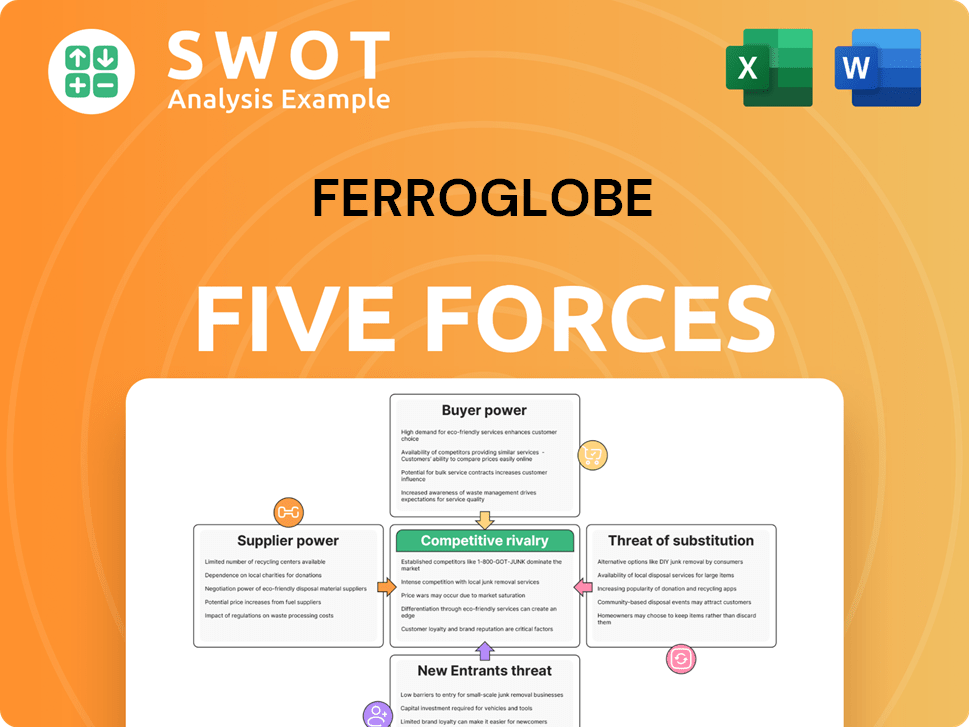
Related Blogs
- What are Mission Vision & Core Values of Ferroglobe Company?
- What is Competitive Landscape of Ferroglobe Company?
- What is Growth Strategy and Future Prospects of Ferroglobe Company?
- How Does Ferroglobe Company Work?
- What is Brief History of Ferroglobe Company?
- Who Owns Ferroglobe Company?
- What is Customer Demographics and Target Market of Ferroglobe Company?
Disclaimer
All information, articles, and product details provided on this website are for general informational and educational purposes only. We do not claim any ownership over, nor do we intend to infringe upon, any trademarks, copyrights, logos, brand names, or other intellectual property mentioned or depicted on this site. Such intellectual property remains the property of its respective owners, and any references here are made solely for identification or informational purposes, without implying any affiliation, endorsement, or partnership.
We make no representations or warranties, express or implied, regarding the accuracy, completeness, or suitability of any content or products presented. Nothing on this website should be construed as legal, tax, investment, financial, medical, or other professional advice. In addition, no part of this site—including articles or product references—constitutes a solicitation, recommendation, endorsement, advertisement, or offer to buy or sell any securities, franchises, or other financial instruments, particularly in jurisdictions where such activity would be unlawful.
All content is of a general nature and may not address the specific circumstances of any individual or entity. It is not a substitute for professional advice or services. Any actions you take based on the information provided here are strictly at your own risk. You accept full responsibility for any decisions or outcomes arising from your use of this website and agree to release us from any liability in connection with your use of, or reliance upon, the content or products found herein.